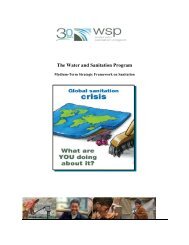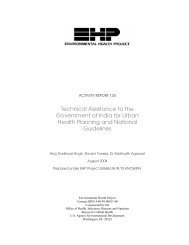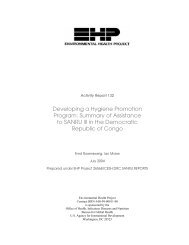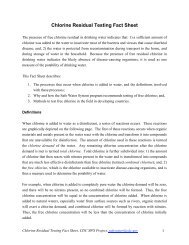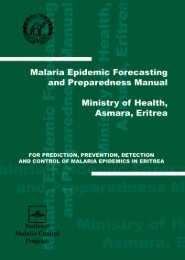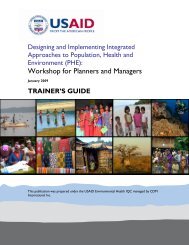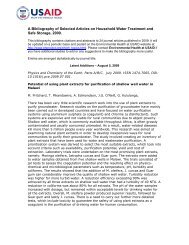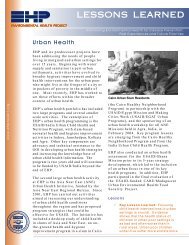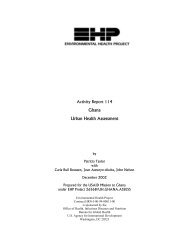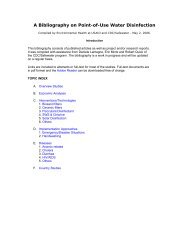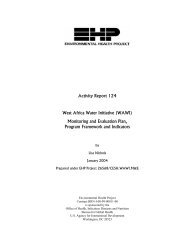Changing Glaciers and Hydrology in Asia - Environmental Health at ...
Changing Glaciers and Hydrology in Asia - Environmental Health at ...
Changing Glaciers and Hydrology in Asia - Environmental Health at ...
- No tags were found...
Create successful ePaper yourself
Turn your PDF publications into a flip-book with our unique Google optimized e-Paper software.
SECTION 5APPROACHES TO ADDRESSING CLIMATE-CHANGE IMPACTS ONGLACIERS AND HYDROLOGYThe three previous sections elabor<strong>at</strong>e on the st<strong>at</strong>e of the science rel<strong>at</strong>ed to glacier melt, thepotential vulnerabilities to associ<strong>at</strong>ed impacts, <strong>and</strong> the survey of organiz<strong>at</strong>ions already engaged <strong>in</strong>activities <strong>in</strong>tended to address glacier-rel<strong>at</strong>ed hydrological changes <strong>and</strong> impacts. This sectiondraws on these streams of <strong>in</strong>form<strong>at</strong>ion to gener<strong>at</strong>e cross-sectoral program concepts <strong>and</strong>approaches th<strong>at</strong> are designed to produce co-benefits across sectors.These program concepts <strong>and</strong> approaches were developed by a team of cross-sectoral specialistswith the follow<strong>in</strong>g criteria <strong>in</strong> m<strong>in</strong>d:Address priority issues rel<strong>at</strong>ed to glacier melt <strong>and</strong> retre<strong>at</strong> <strong>in</strong> a cross-sectoral waydesigned to yield co-benefits <strong>in</strong> multiple sectorsComplement or fill gaps, consider<strong>in</strong>g activities already underwayCorrespond with USAID’s <strong>in</strong>terests <strong>and</strong> m<strong>and</strong><strong>at</strong>eThe program concepts <strong>and</strong> approaches are <strong>in</strong>tended to be used as a “menu” of possibleprograms to choose from r<strong>at</strong>her than as a cookbook of recipes th<strong>at</strong> must be followed. DifferentMissions, tak<strong>in</strong>g account of current conditions <strong>in</strong> their countries as well as potential partners<strong>and</strong> synergies with ongo<strong>in</strong>g programs, can choose or adapt any of these or develop otherprograms. Programs th<strong>at</strong> address cross-sectoral issues rel<strong>at</strong>ed both to glacier melt impacts <strong>and</strong>general development, such as w<strong>at</strong>er management <strong>and</strong> health, have the advantage of n<strong>at</strong>uralconnections with many of USAID’s programs <strong>and</strong> <strong>in</strong>iti<strong>at</strong>ives. As such, they yield the k<strong>in</strong>d of “noregrets” co-benefits th<strong>at</strong> <strong>in</strong>crease the well-be<strong>in</strong>g of societies both <strong>in</strong> the short term <strong>and</strong> the longterm.As clim<strong>at</strong>e change is a long-term issue, extend<strong>in</strong>g program timel<strong>in</strong>es beyond 3-5 years <strong>and</strong>explicitly coord<strong>in</strong><strong>at</strong><strong>in</strong>g projects across sectoral <strong>and</strong> geographic boundaries should be considered.One option would be to l<strong>in</strong>k projects th<strong>at</strong> could be completed <strong>in</strong> sequence, <strong>in</strong> order to allowfor periodic evalu<strong>at</strong>ion <strong>and</strong> course correction, <strong>in</strong>stitutionaliz<strong>at</strong>ion of best practices, <strong>and</strong> scale-up.Another option is to coord<strong>in</strong><strong>at</strong>e programs with other Missions <strong>and</strong>/or sectors, explor<strong>in</strong>gmechanisms to share resources <strong>and</strong> management.Section 2 concluded th<strong>at</strong>, overall, with regard to glacier melt, scientists lack knowledge aboutthe r<strong>at</strong>e of melt <strong>and</strong> impacts of the phenomenon. This knowledge would help societies plan forthe changes <strong>and</strong> adapt to them. Many questions rema<strong>in</strong> about wh<strong>at</strong> those changes will be,especially with regard to downstream areas (see table on the follow<strong>in</strong>g page). This lack ofknowledge, also confirmed by the survey of organiz<strong>at</strong>ions discussed <strong>in</strong> Section 4, constitutes alarge vulnerability.Therefore, the first program concept <strong>in</strong> this section addresses the need for collabor<strong>at</strong>ive <strong>and</strong><strong>in</strong>tegr<strong>at</strong>ed scientific efforts to <strong>in</strong>crease scientific knowledge <strong>and</strong> to engage <strong>in</strong> monitor<strong>in</strong>g changes<strong>in</strong> glaciers. The program approaches associ<strong>at</strong>ed with improv<strong>in</strong>g scientific knowledge <strong>and</strong> d<strong>at</strong>a49



